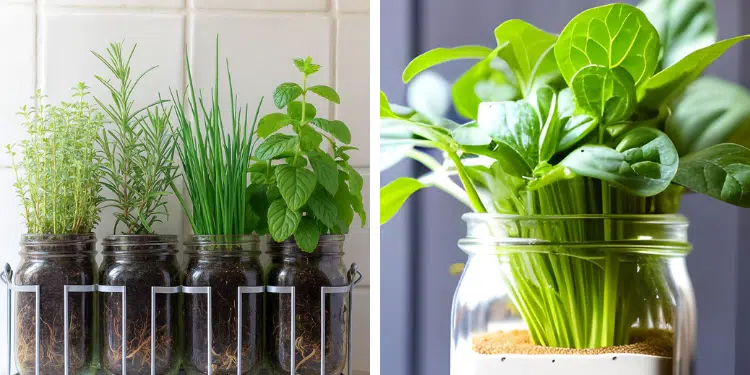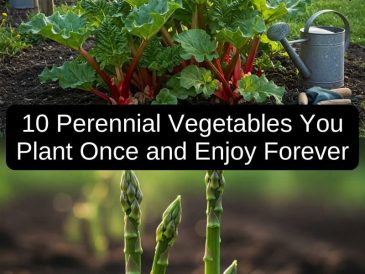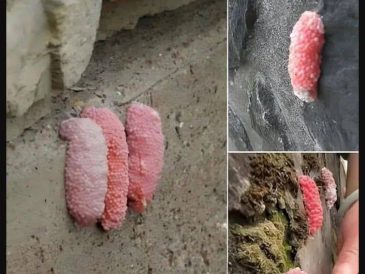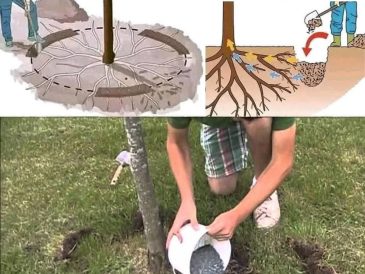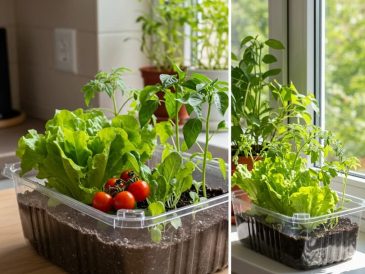Getting Started: The Basics of Growing in Mason Jars
Before planting, you’ll need a few essentials to set up your jars for success.
Choose the Right Jar Size
- Small jars (8 oz–12 oz): Best for microgreens, green onions, or sprouts.
- Medium jars (16 oz–24 oz): Great for herbs like basil, mint, or cilantro.
- Large jars (32 oz+): Suitable for leafy greens, strawberries, or dwarf tomatoes.
Create Drainage (The Most Important Step)
Unlike regular pots, mason jars don’t have holes at the bottom, so drainage is key.
Here’s how to do it:
- Add a 1–2 inch layer of pebbles, gravel, or perlite at the bottom of each jar.
- This allows excess water to collect without suffocating roots.
- Optionally, place a piece of mesh or coffee filter above the gravel before adding soil.
Use the Right Soil
Go for light, well-draining potting mix. Avoid heavy garden soil.
For herbs and leafy greens, a mix of:
- 2 parts potting mix
- 1 part perlite or vermiculite
- 1 part compost
Light and Location
Most edible plants need 4–6 hours of sunlight daily. South-facing windowsills are ideal. If natural light is limited, consider a small LED grow light.
Watering and Feeding
Jar plants dry out more slowly because there’s no drainage hole, so water sparingly:
- Check moisture by touching the soil surface.
- Water only when the top inch feels dry.
- Fertilize lightly every 2–4 weeks using liquid organic fertilizer or compost tea.
10 Foods You Can Grow in Mason Jars
Now, let’s dig into the exciting part – the plants themselves. These 10 foods are easy, rewarding, and thrive in small glass containers.
1. Green Onions (Scallions)
Why They’re Perfect for Jars
Green onions are one of the easiest plants to regrow endlessly from kitchen scraps. All you need are leftover root ends from store-bought onions.
How to Grow
- Cut off the white root base, leaving about 1–2 inches of stem.
- Place the roots in a jar with just enough water to cover them.
- Set near a sunny window and change the water every few days.
- New green shoots will emerge in 5–7 days.
Once they grow a few inches, you can either harvest or transfer them to a jar filled with potting soil for longer growth.
Harvest
Trim the greens when they’re 6–8 inches tall. They’ll regrow repeatedly as long as roots remain healthy.
2. Basil
Why It Thrives in Jars
Basil loves warm, sunny windowsills and doesn’t require deep soil. Its roots stay compact, making it an ideal jar herb.
How to Grow
- Fill a 16–20 oz jar with moist potting mix.
- Plant basil seeds ¼ inch deep, or transplant small seedlings.
- Place the jar in a warm, sunny spot (at least 6 hours of light).
- Keep the soil consistently moist but not soggy.
Pro Tip
Pinch off flower buds as soon as they appear to keep the plant producing leaves longer.
Harvest
Begin snipping leaves once the plant reaches 6 inches tall. Always harvest from the top to encourage branching.
Why It’s Ideal
Mint is hardy, fast-growing, and forgiving – even if you forget to water occasionally. It also naturally repels insects and gives your kitchen a refreshing scent.
How to Grow
- Fill a 16–20 oz jar with soil.
- Plant mint cuttings or root divisions about 2 inches deep.
- Keep soil slightly moist and provide bright, indirect light.
Pro Tip
Don’t mix different mint varieties in one jar – they’ll compete and cross flavors.
Harvest
Pick leaves regularly to encourage new growth. Use them fresh in tea, desserts, or drinks.
5. Spinach
Why It’s a Smart Choice
Spinach grows quickly and thrives in cool temperatures. It doesn’t need deep roots, making it perfect for jars.
How to Grow
- Use a large jar (1 quart or more).
- Fill with loose, fertile soil rich in compost.
- Sow 2–3 seeds per jar, ½ inch deep.
- Keep in a bright but cool place (60°F is ideal).
Watering Tip
Water when the top inch of soil feels dry. Avoid overwatering – spinach dislikes soggy roots.
Harvest
Cut outer leaves once they reach 3–4 inches long. New leaves will continue to grow from the center.
6. Garlic Greens
Why They’re Unique
Instead of growing full garlic bulbs (which require deep soil), you can grow garlic greens – tender shoots with a mild garlic flavor.
How to Grow
- Fill a jar halfway with potting mix.
- Push 3–4 garlic cloves (unpeeled) into the soil, pointy side up.
- Water lightly and place in sunlight.
Growth Timeline
Shoots appear within a week and reach full height in 10–14 days.
Harvest
Snip the green shoots when they’re 6–8 inches tall. Each clove produces one round of greens.
7. Strawberries
Why It’s Possible
Yes, strawberries can grow in mason jars – especially everbearing or alpine varieties that stay compact and produce small fruits.
How to Grow
- Choose a large jar (32 oz or bigger).
- Add a drainage layer, then fill with rich potting soil.
- Plant one strawberry crown with roots spread out.
- Keep in bright sunlight (6+ hours per day).
- Water consistently but avoid soggy soil.
Pro Tip
Rotate jars occasionally so all sides receive light evenly.
Harvest
Fruits typically appear after 8–10 weeks. Pick them as soon as they turn red and aromatic.
8. Cilantro (Coriander)
Why It Works in Jars
Cilantro has shallow roots and grows best in cool, bright conditions – exactly what most kitchen windows offer in spring and fall.
How to Grow
- Fill a medium jar with soil and plant seeds ¼ inch deep.
- Keep moist and ensure at least 4 hours of sunlight daily.
- Thin seedlings once they’re 2 inches tall.
Growth Tip
Cilantro tends to bolt (flower) in heat. Keep it cool and harvest leaves regularly to extend its life.
Harvest
Begin picking leaves 3–4 weeks after planting. You can also let a few plants flower to collect coriander seeds.
9. Microgreens
Why They’re the Easiest
Microgreens are edible seedlings of vegetables and herbs like kale, radish, broccoli, and mustard. They grow quickly and require minimal space – making mason jars ideal mini greenhouses.
How to Grow
- Fill a shallow jar or bowl-style jar with 2 inches of soil or coconut coir.
- Sprinkle seeds densely on top.
- Mist daily with water – never soak.
- Keep in bright indirect light.
Timeline
You’ll see sprouts in 2–3 days and harvest-ready greens in 7–14 days.
Harvest
Snip just above the soil surface. Eat them fresh in salads, sandwiches, or smoothies.
10. Sprouts
Why It’s Revolutionary
Sprouts – such as alfalfa, mung beans, lentils, and broccoli – are the fastest food you can grow in jars, requiring no soil at all.
How to Grow
- Place 1–2 tablespoons of seeds in a clean jar.
- Cover with mesh or cheesecloth and secure with a rubber band.
- Add water, swirl to rinse, then drain.
- Leave the jar tilted upside down to allow airflow.
- Rinse and drain twice daily.
Within 3–5 days, you’ll have a jar full of crisp, nutrient-dense sprouts.
Storage
Once ready, store sprouts in the refrigerator for up to a week. Always rinse before eating.
Bonus: 5 Tips for Success in Jar Gardening
Even though growing food in mason jars is simple, these five advanced tips can help you master the art of small-space gardening.
1. Use Reflective Surfaces
Place aluminum foil or a white surface behind your jars to reflect light onto shaded sides. It prevents plants from leaning toward the window.
2. Rotate Jars Weekly
Turn each jar 180° every few days so light reaches all sides evenly, ensuring symmetrical growth.
3. Refresh Soil Every Few Months
Over time, nutrients deplete. Either top-dress with compost or replace the top 2 inches of soil with fresh mix.
4. Clean Jars Thoroughly
Wash jars between plantings with mild soap and water to remove salts and prevent mold buildup.
5. Pair Plants Strategically
Group herbs with similar watering needs together. For instance:
- Basil, parsley, and cilantro like consistent moisture.
- Mint and oregano tolerate slight dryness.
This helps you manage watering schedules easily.
Common Problems and How to Fix Them
| Problem | Cause | Solution |
|---|---|---|
| Yellowing leaves | Overwatering or lack of nutrients | Check drainage and feed with diluted compost tea |
| Mold on soil | Poor air circulation or excess moisture | Remove top layer, add perlite, and improve airflow |
| Drooping stems | Not enough light | Move to a sunnier window or add a grow light |
| Stunted growth | Root bound or depleted soil | Repot into larger jar or refresh soil mix |
How to Reuse Tea or Coffee Grounds in Your Mason Jar Garden
Used tea leaves or coffee grounds make an excellent natural fertilizer for your jar plants.
- Sprinkle a thin layer over the soil once a month.
- Mix gently into the top layer to prevent mold.
They add trace nitrogen and improve microbial activity in small indoor ecosystems.
Seasonal Growing Guide for Jar Plants
| Season | What to Grow |
|---|---|
| Winter | Green onions, garlic greens, microgreens, mint |
| Spring | Lettuce, basil, cilantro, spinach |
| Summer | Strawberries, basil, sprouts |
| Fall | Kale microgreens, mint, green onions |
Health and Sustainability Benefits
Growing food in mason jars does more than save money – it contributes to a healthier lifestyle and planet.
- Reduces food waste: You regrow scraps like green onions or garlic.
- Cuts packaging waste: No need for store-bought plastic herbs.
- Improves air quality: Indoor plants filter toxins and boost oxygen.
- Promotes mindful eating: You reconnect with the food you grow.
- Perfect for urban living: Brings nature into kitchens, offices, or dorms.
When to Transition Jar Plants Outdoors
Some plants – like strawberries, basil, and mint – can eventually outgrow their jars. When roots fill the glass or growth slows, it’s time to transplant outdoors or into larger containers.
To avoid shock:
- Gently loosen roots and remove excess soil.
- Plant into a pot with drainage holes and fresh compost.
- Keep in partial shade for a few days before moving to full sun.
Your jar will then be free for a new round of seedlings.
Creative Ideas: Turning Jar Gardens into Decor
- Hanging Herb Wall: Mount jars on wooden boards with metal clamps.
- Windowsill Salad Bar: Grow lettuce, arugula, and spinach in a row of jars.
- Kitchen Tea Garden: Grow mint, chamomile, and lemon balm for fresh herbal tea.
- Gift Idea: Layer soil, seeds, and a note in jars – perfect eco-friendly presents.
Mason jar gardens aren’t just functional; they’re a beautiful expression of sustainable living.
A single mason jar might seem insignificant, but it can grow real food – food you can see, touch, and taste.
Whether it’s a sprig of mint for your tea, a handful of lettuce for your sandwich, or fresh basil for your pasta, these tiny gardens bring nourishment and joy into everyday life.

